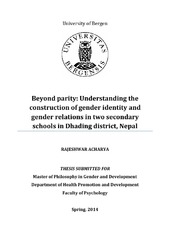| dc.description.abstract | A majority of academic and non-academic studies and debates on gender and education at international and national level centers around gender parity in education. Thus this study is an attempt to move beyond this vantage point towards understanding students' activities, interactions and experiences regarding their gender, caste and/or ethnicity from their own perspectives. This qualitative study was conducted in two governmental schools in Naubise village development committee of Dhading district of Nepal. The study focuses on how' grade nine and ten students of Nepali governmental schools reaffirm or restructure their gender identity along with caste and ethnic identities in multiple spaces and contexts both inside and outside schools. The findings of this study show that student' gender identity, and also their caste and ethnic identities, is fluid and changing from one context to another. Depending upon the contexts and situations the students are in, their gender along with caste and/or ethnic identities becomes more or less relevant among them. In a majority of occasions, the construction of gender identity and relations among students was an active and ongoing process often facilitated by themselves through performing gender in their activities and interactions. Such gender specific behaviors and acts were further supported by teachers, school authorities, curricula which were guided by the existing patriarchal norms and values in Nepali society. Nevertheless, students also were actively negotiating their gender identity and relations depending on the place where they are conducting their activities and people who are witnessing such activities. But it was difficult for students to challenge the dominant gendered norms and values that remain unchallenged in society and, to some extend also in schools. The national and local educational plans and policies in Nepal largely focus on social inclusion in education by increasing access of the disadvantaged groups including women, dalits and ethnic groups. But with too much focus on access, the national and local level educational plans and programs often tend to overlook other crucial aspects of gender inequality in schools. In such context, through this study, I illustrate and argue that along with gender parity, it is equally important to focus on gender dynamics of the students in the schools by taking account of their activities, interactions and experiences of gender in multiple spaces and context inside and outside the schools. | en_US |
